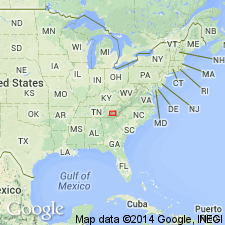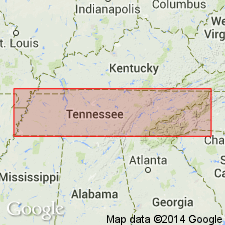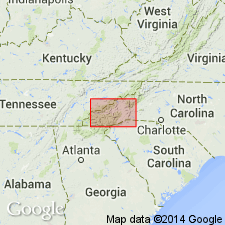
- Usage in publication:
-
- Metcalf phyllite*
- Modifications:
-
- Named
- Dominant lithology:
-
- Phyllite
- Siltstone
- Sandstone
- AAPG geologic province:
-
- Appalachian basin
Summary:
Named as a formation in Snowbird group of Ocoee series. Named for Metcalf Bottoms on Little River, Sevier Co., eastern TN. Occurs in between high ridges of Great Smoky Mountains and cove areas to the northwest. Occurs in a belt extending from Gatlinburg to Cades Cove. Consists of gray-green or gray, lustrous, thinly fissile phyllite. Much of the unit resembles Pigeon siltstone and Roaring Fork sandstone. In most places, Metcalf is faulted against other rocks; thickness cannot be determined. Contact relations are uncertain, but it joins Pigeon siltstone at northeast end of outcrop belt. Probably equivalent to Pigeon and part of Roaring Fork, but is differentiated by greater metamorphism. Age is later Precambrian.
Source: GNU records (USGS DDS-6; Reston GNULEX).

- Usage in publication:
-
- Metcalf Phyllite
- Modifications:
-
- Overview
- AAPG geologic province:
-
- Appalachian basin
Summary:
In Unaka Mountains, used as Precambrian Metcalf Phyllite of Snowbird Group of Ocoee Supergroup.
Source: GNU records (USGS DDS-6; Reston GNULEX).

- Usage in publication:
-
- Metcalf Phyllite*
- Modifications:
-
- Areal extent
- Overview
- AAPG geologic province:
-
- Appalachian basin
Summary:
Included in Snowbird Group of Ocoee Series. Mapped in Blue Ridge belt northwest of Greenbrier-Devils Fork fault and southwest of Pigeon River. Occurs in Blount and Sevier Cos., eastern TN. Consists of gray-green or light-gray phyllite and thinly interbedded metasiltstone; also includes highly feldspathic, medium- to thick-bedded minor metasandstone. Age is late Precambrian.
Source: GNU records (USGS DDS-6; Reston GNULEX).
For more information, please contact Nancy Stamm, Geologic Names Committee Secretary.
Asterisk (*) indicates published by U.S. Geological Survey authors.
"No current usage" (†) implies that a name has been abandoned or has fallen into disuse. Former usage and, if known, replacement name given in parentheses ( ).
Slash (/) indicates name conflicts with nomenclatural guidelines (CSN, 1933; ACSN, 1961, 1970; NACSN, 1983, 2005, 2021). May be explained within brackets ([ ]).

